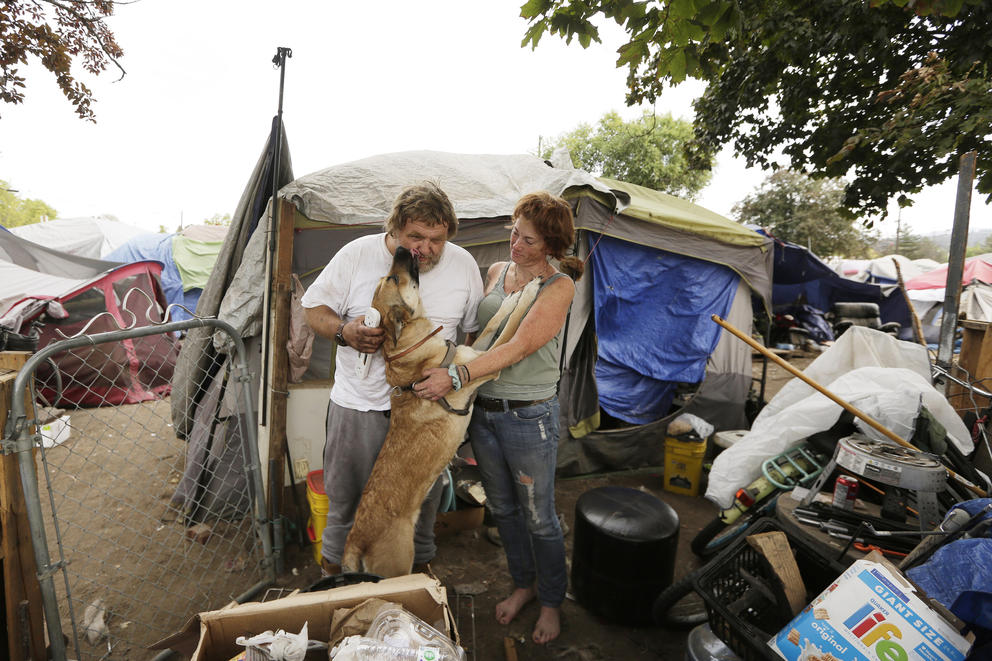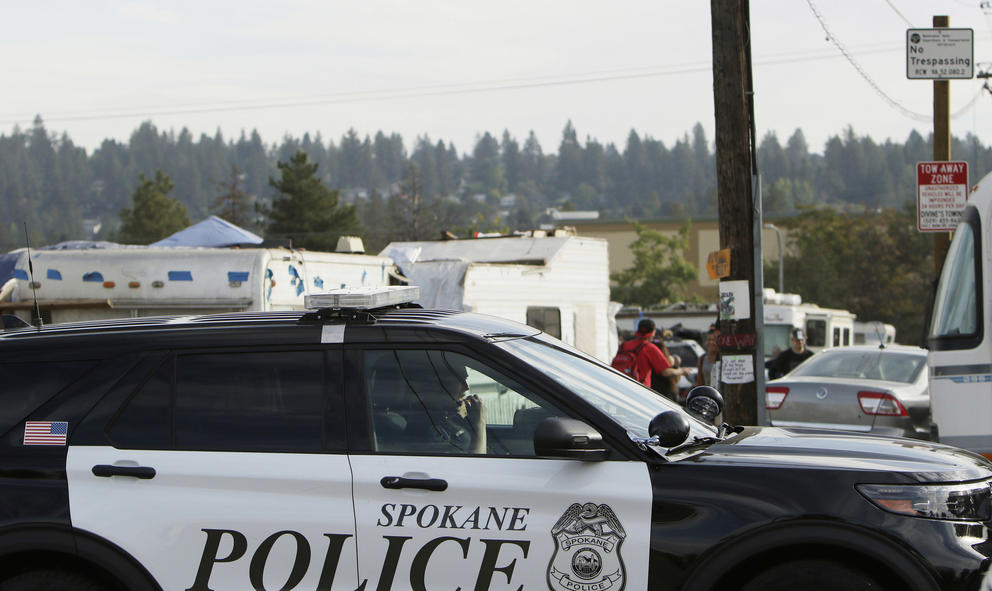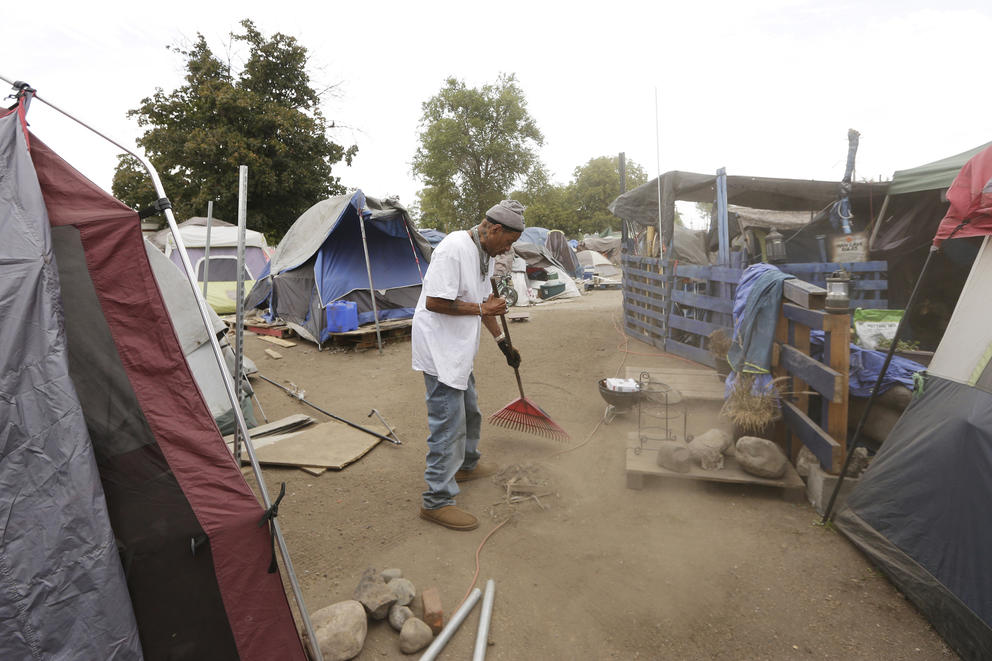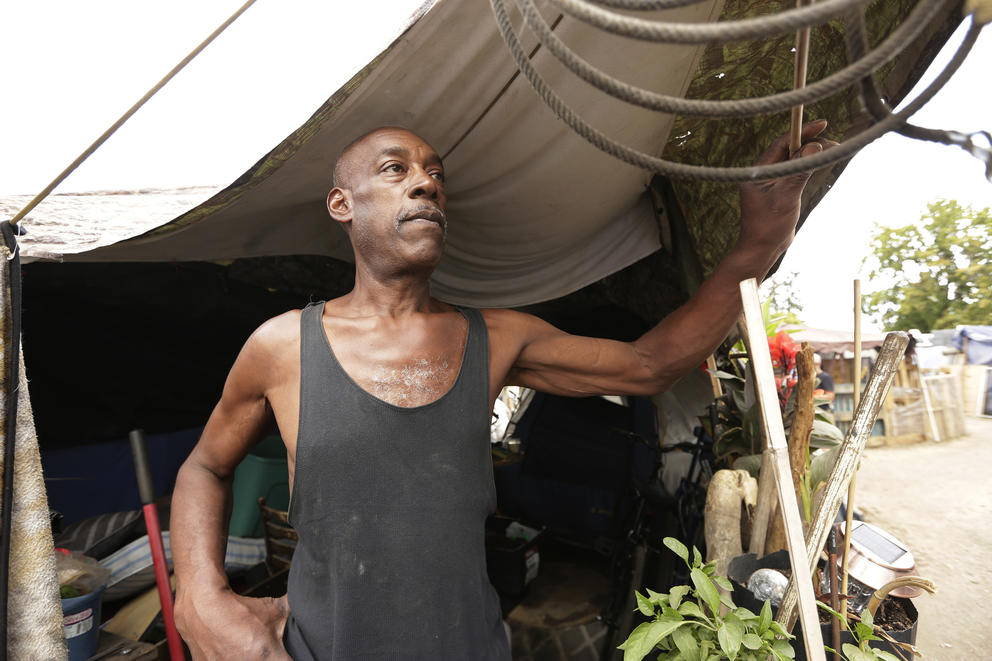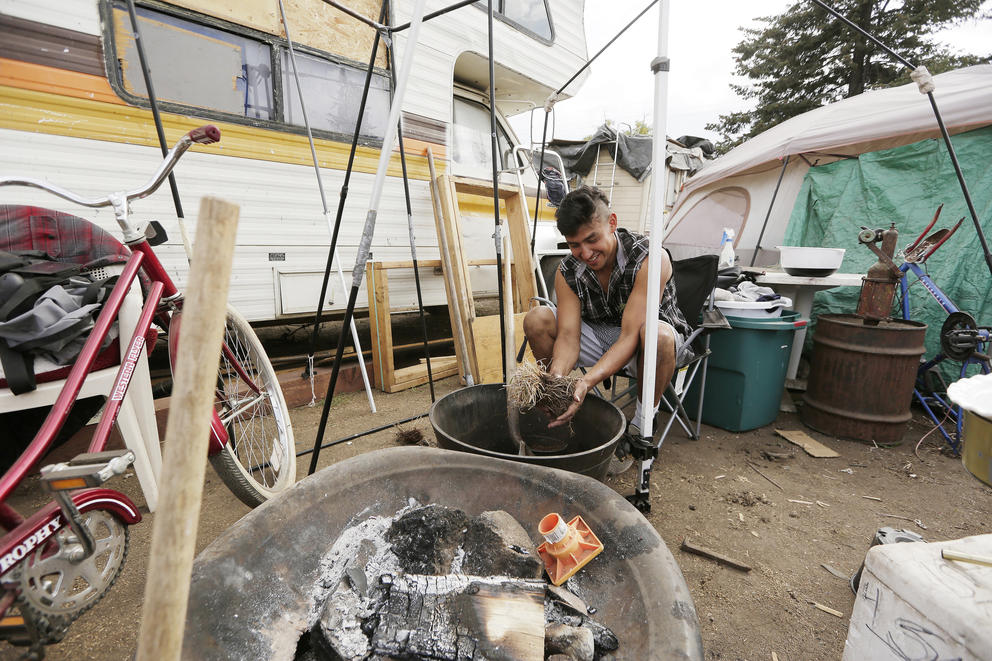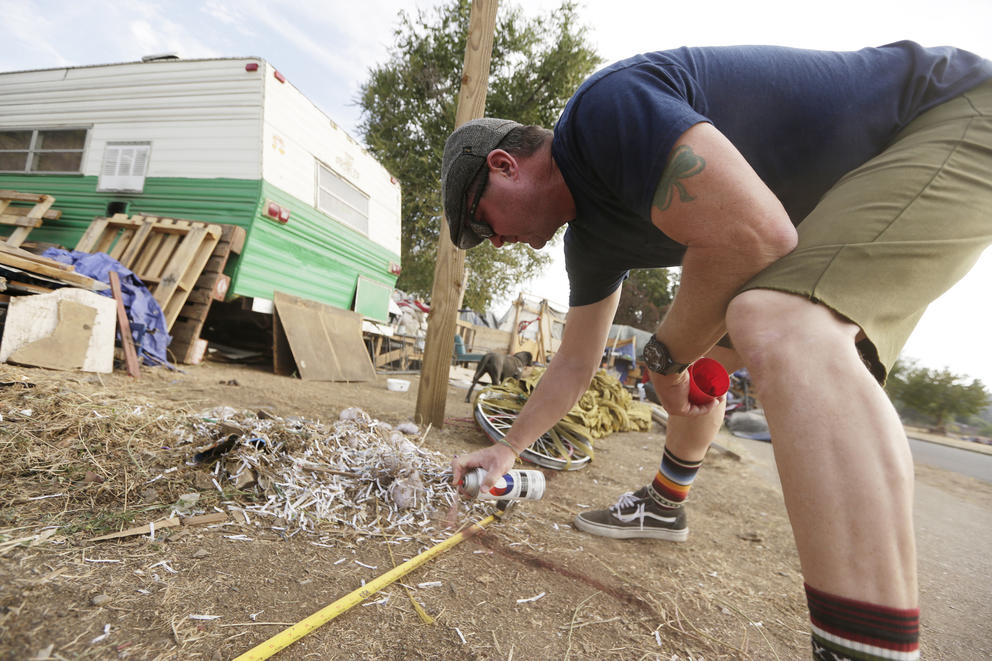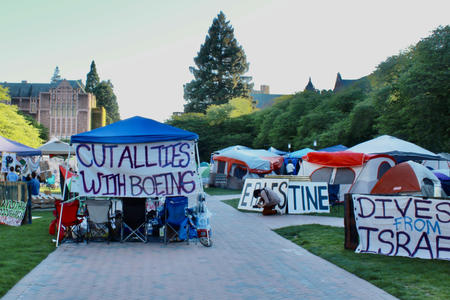But what most people think of when they consider the East Central neighborhood these days is a homeless camp occupying several square blocks, with nearly 450 people living in tents.
Camp Hope, the largest such encampment in the state, has become the face of Spokane County’s rapidly growing housing and homelessness problem.
In recent months, Spokane city and county leaders have been squabbling with the state agencies over its future. All claim they have been been trying to work with each other and service providers to help the residents find permanent housing, but the arguments have captured a lot of the energy in the discussion.
Local government leaders, including Mayor Nadine Woodward and Spokane County Sheriff Ozzie Knezovich, have declared the encampment a nuisance and are working to clear it within the next few weeks.
Meanwhile, leaders from the state agencies, including the Department of Transportation — owners the property on which Camp Hope sits — are not mincing words on their concern over the city and county’s actions.
Clearing out Camp Hope prematurely “will simply force the most vulnerable to relocate to other city, county, state and private [-ly owned] property within the area. Acting on the city’s ill-considered demand solves nothing for anyone,” Transportation Secretary Roger Millar, Commerce Secretary Lisa Brown and Washington State Patrol Chief John Batiste wrote in a Sept. 20 letter to Johnnie Perkins, city administrator for Spokane.
Those in the neighborhood feel caught in the middle, said McGlenn, who moved out of the area a year ago but still runs his computer business there.
The encampment has hurt the neighborhood — namely, in declining business activity, as residents and visitors express safety concerns over the encampment’s presence, McGlenn said.
But McGlenn said while there is strong support from some neighbors and the business community to clear out the encampment, others believe that is not a perfect solution either, especially if it means Camp Hope’s residents disperse to other neighborhoods around the city.
He also doesn’t like local officials’ lack of will to get past political arguments and do the hard work of crafting solutions.
“I know the neighborhood wants the camp gone and addressed swiftly, but we’re not addressing it swiftly unless we address why these folks are homeless,” McGlenn said.
Spokane County’s growing housing unaffordability
According to a point-in-time count by the City of Spokane in late February, the county now has 1,757 homeless residents. The figure is a rough estimate, and many advocates for the unhoused believe the actual number is likely higher.
Still, the count does point to a sharp rise in homelessness — the count was in the 1,000-to-1,200 range between 2009 and 2017.
Those overseeing homelessness data in Spokane’s Community, Housing & Human Services Department noticed a concerning correlation: the rise in homelessness in Spokane County as a whole due to a rapid decline in housing affordability.
For much of the previous decade, Spokane County was well above 100 on the housing-affordability index, indicative of strong housing affordability. At specific points, it was upward of 200. But it has since fallen to below 100 this year.
Figures from the Washington Center for Real Estate Research shows the average rent for all apartments was nearly $1,300 a month as of the third quarter of 2022. That’s a whopping 51% increase from just $853 a month during the same period in 2016.
Not only is housing more expensive in Spokane, but it has become more challenging to find. According to figures from the Washington Center for Real Estate Research, the apartment vacancy rate for Spokane was as low as 1.6% in the fall of 2016; it has since increased but remains at just 3.7% as of the third quarter of this year.
So perhaps it’s not a surprise that a supermajority of homeless people in Spokane County — contrary to the standard narrative — are from the area. County data shows that 74% of those surveyed had been living in the county when they became unhoused. And 58% of homeless residents have lived in the Spokane area for at least a decade.
Shelter bed availability
The point-in-time count also showed that 823 — or 47% — of the 1,757 homeless residents counted were living outside of emergency or traditional shelters.
Camp Hope started as a protest over the lack of available shelter beds. In late 2021, homeless residents camped outside Spokane’s City Hall to protest the lack of “low-barrier” beds — those that allow people to come in without requirements, such as identification or proof of sobriety. Low-barrier shelter has become the standard nationally, as homelessness service providers adopt the “housing first” model first developed in Seattle and elsewhere.
The encampment was moved to its current location in the East Central neighborhood, on property owned by the state Department of Transportation. That made the encampment eligible for funding through the state’s Right of Way Initiative, which aims to help move residents living in state-owned right-of-ways into housing.
Through this program, the Department of Transportation, in collaboration with other agencies including the state Department of Commerce and Washington State Patrol, has worked with service providers to maintain services, such as mental and physical health care, clothing and food, at Camp Hope and with residents to get them into transitional or permanent housing.
About $25 million in state dollars is available for various housing solutions. That has included contracting with several nonprofits for outreach to the unhoused, including running the Camp Hope encampment — and funding Catholic Charities of Eastern Washington's effort to purchase and renovate a former motel into housing.
Julie Garcia of Jewels Helping Hands, a nonprofit contracted by the state to manage the encampment, said more than 100 residents have transferred to housing, but more time is needed to find places for nearly 450 residents still on site.
Garcia said the encampment is not a free-for-all. Service providers come to the site to provide food, health care and other basic needs. Recently, a fence was installed around the encampment to increase security and separate the encampment from the rest of the neighborhood. Camp Hope residents are also under a curfew.
Still, such efforts haven’t been good enough for city and county officials who maintain that the encampment is a nuisance property and needs to be emptied.
Spokane County Commissioners approved on a resolution earlier this month to pursue legal action to quicken a clearing-out of the encampment.
“This is the next step in a process in correcting, quite frankly, something that has gotten completely out of hand at the fault of [the state Department of Transportation] and the Department of Commerce,” said Commissioner Josh Kerns just before the resolution was passed.
Sheriff Ozzie Knezovich went on Fox News to declare how Camp Hope has “devastated the neighborhood” and generated increased criminal activity.
Garcia said that Knezovich has never visited Camp Hope. During a recent Spokane County Commission meeting, Knezovich said he’s informed through staff who have visited the encampment and through other means. He blamed “liberal policies” for the mess.
Knezovich did not return calls requesting comment for this story.
Spokane County Commissioners were also not available for comment but have issued a statement on why they were taking legal action:
“Commissioners approved this action in support of the Spokane County sheriff’s determination to address the situation at Camp Hope and to ensure an opportunity for interested parties to appear before a Spokane County Superior Court Judge regarding the impacts of the current encampment on our community,” the statement said.
Meanwhile, Spokane Police sent a warning to the state Department of Transportation and those running Camp Hope, stating the encampment has led to increased crime and other negative effects that have cost the city hundreds of thousands of dollars.
In public comments at various meetings, local government officials are using the increase in crime, and what it believes would be a more humane situation for residents come winter, to generate urgency to clear the camp.
The city and county also launched an emergency operations center this week to execute plans to clear out the camp.
Brian Coddington, a spokesman for the city of Spokane, said the city has shelter space to house Camp Hope residents.
Coddington said there had been ample shelter space since the summer. And the recently opened Trent Resource and Assistance Center, a city-owned shelter, can be expanded to house upwards of 400 residents. City officials in various comments and correspondence maintain between the Trent facility and other shelters there are nearly 600 beds available, a figure that is disputed by state agencies and homeless advocates.
Camp Hope “has gone for many months with no resolution,” he said. “The primary factor is getting people out of the elements into a shelter location where they can have the same access to services, same direction to housing.”
Garcia said that her organization, in cooperation with state agencies and other nonprofits, has established a system and trust among those who live in the encampment.
Clearing Camp Hope won’t solve the issue of homelessness in Spokane, she said, as unhoused people live in different parts of Spokane, not just at Camp Hope.
She said she plans to continue running the camp unless she is forced to do otherwise.
“We’re continuing to move forward the same way we were,” she said.
Advocates for the unhoused believe the public political battle over Camp Hope is a distraction from a clear reality: relative inaction from city and county officials when they had years to address the issue.
“Broadly speaking, the city, the people here have not wanted to face the reality of homelessness and how significant it is,” said Zeke Smith, president of the Empire Health Foundation. “People at a bunch of levels wanted to put their blinders on and in some ways have been able to do that until last year, until the establishment of Camp Hope.”
Empire Health Foundation, an organization that works toward health equity in the Inland Northwest, was tapped earlier this year to facilitate a coalition to discuss solutions to address homelessness in the region. Before a few months ago, the organization did not work with homelessness, but business and community leaders believed the organization could help craft an alternative approach, Smith said.
The foundation hired a consultant and scheduled several sessions where 30 to 40 service providers, government officials and others could talk and come up with solutions. Through this conversation, participants realized one key reason it was challenging to address the homelessness issue in Spokane: In spite of all the political debate over the issue, there was relatively little discussion on the full scope of the situation and what has been done about it.
One example came when someone in the group asked how many homeless outreach workers were active in the Spokane area.
“We spent 30 minutes trying to answer the question and couldn’t come up with an answer,” Smith said. “We don’t have any system that incorporates or includes outreach workers. If we don’t know how many outreach workers are in the system, how can we identify how many more we need?”
After meeting for three months, the coalition came up with a document that recommended short- and long-term solutions to address homelessness in Spokane, including how to spend state funding provided by the Commerce/WS-DOT Right of Way program and federal funding through the American Rescue Plan.
The recommendations include purchasing pallet homes and paying for health services and outreach to the residents of Camp Hope. The document recommended paying for 30 outreach workers to work in the region for three years.
The coalition sent the recommendations to the city of Spokane and Spokane County this summer, but those governments have not yet adopted them. Still, Smith believes the coalition illustrated that the community can come together to come up with solutions despite differing viewpoints and philosophies. He hopes this experience will lead to additional collaboration.
One actual result: Empire Health Foundation is fully invested in addressing homelessness in the community. The state contracted with the organization to help with outreach to those living at Camp Hope, helping them connect with various services and resources. It wasn’t a role Smith or the staff anticipated playing, but they didn’t want to pass up the opportunity to develop solutions.
The foundation, along with Jewels Helping Hands and Compassionate Addiction Treatment have worked on a system that serves residents on site rather than forcing them to move elsewhere.
“I continue to think we could build a more collaborative and coordinated system and give people a sense of what it looks like and feels like to get some real wins and real changes,” Smith said.
Humanizing Camp Hope
For McGlenn, the East Central Neighborhood Council chairman, there was an unexpected silver lining to the existence of Camp Hope in the neighborhood: the ability to reconnect with an old friend (McGlenn lost contact with this friend after he could not help him deal with substance-abuse issues).
Camp Hope was true to its name for this friend: When McGlenn saw him in the encampment, he found his friend was employed with an organization on site and looked much healthier.
For McGlenn, the experience of seeing his friend humanized Camp Hope’s residents and made him more skeptical about the narrative crafted by some.
“[My friend] is not the kind of person that deserves to get arrested by the Sheriff’s Department because he has nowhere to go,” he said. “These people are trying to do something to better themselves. They got to understand it takes time. It’s not an instant solution.”

